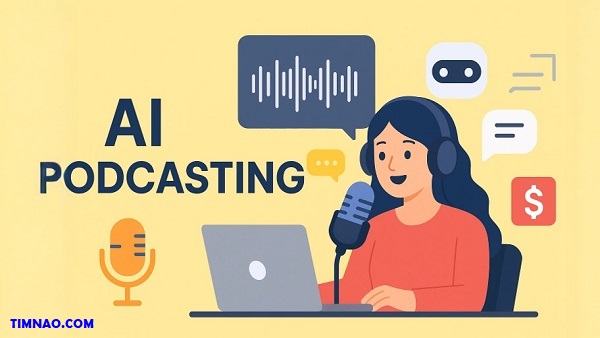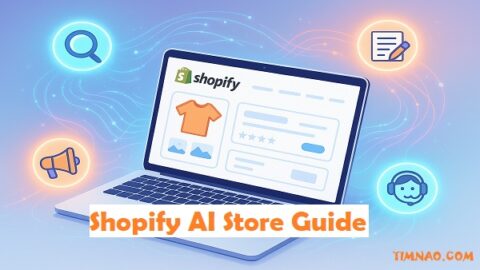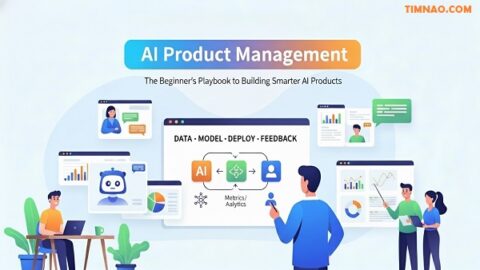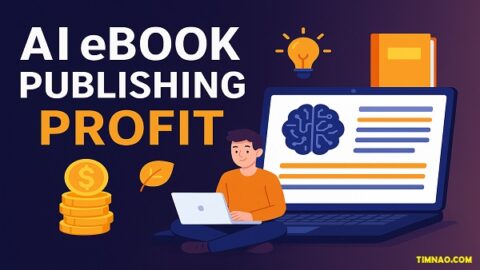AI Podcasting Secrets 🚀 How to Launch, Grow & Profit From Your Show in 2025
AI podcasting is no longer just a futuristic concept — it’s a game-changing way for anyone, even complete beginners, to create, grow, and monetize their own show without a huge budget, fancy equipment, or years of experience. Thanks to powerful AI tools, what used to take hours (or even days) — like writing scripts, recording voiceovers, editing audio, designing cover art, and promoting episodes — can now be done in minutes.
In 2025, the barrier to entry for podcasting has never been lower. You don’t need a studio, a team of editors, or advanced tech skills. With the right AI podcasting content creation tools, you can plan an episode over coffee, record it on your laptop or even with an AI-generated voice, polish it instantly, and have it streaming on platforms like Spotify or Apple Podcasts the same day.
But here’s the exciting part — AI doesn’t just make podcasting faster and easier. It also opens up new ways to make money with AI podcasting that weren’t possible before: from personalized ad targeting to multilingual episodes that reach audiences around the globe.
This guide is designed for beginners who want clear, actionable steps to launch and grow a profitable AI-powered podcast. Whether you dream of sharing your expertise, building a personal brand, or creating a passive income stream, you’ll find practical strategies, proven tools, and real-world examples that you can start applying today.
By the end, you’ll have a complete roadmap — from idea to monetization — so you can join the growing wave of creators using AI to revolutionize podcasting in 2025 and beyond.
📚 Table of Contents:
- 🎙 Why AI Podcasting Is the Perfect Opportunity in 2025
- 🤖 How AI is Revolutionizing Podcast Creation
- 🛠 Essential AI Tools for Starting Your Podcast
- 📝 Step-by-Step Guide: Launching Your AI-Powered Podcast
- 💡 Content Ideas That Work Best for AI Podcasts
- 💰 7 Strategies to Make Money With AI Podcasting
- 📈 Tips to Grow Your Podcast Audience Fast
- ⚙️ Scaling and Automating Your AI Podcasting Business
- ⚠ Common Mistakes to Avoid With AI Podcasting
- 🔮 The Future of AI Podcasting – Trends to Watch
🎙 Why AI Podcasting Is the Perfect Opportunity in 2025
Podcasting has been growing steadily for over a decade, but 2025 is a unique moment for anyone ready to jump in — especially if you use AI. According to industry data, there are now over 500 million podcast listeners worldwide, and the audience keeps growing. Yet, there’s still plenty of room for new voices, particularly in niche topics.
The big change? AI podcasting has lowered the barrier to entry. In the past, you needed expensive microphones, editing software, and hours of manual work to produce each episode. Now, with AI tools, you can create high-quality audio in a fraction of the time — and without being a tech expert.
This is why AI podcasting is the perfect opportunity in 2025:
- Low startup cost – Many AI tools are free or have affordable plans.
- Faster production – AI can handle editing, transcription, and even voiceovers.
- Global reach – AI can translate your podcast into multiple languages.
- High monetization potential – From sponsorships to selling your own products.
If you’re wondering whether there’s still a chance to stand out, the answer is yes — but you need to be strategic. Instead of competing with big shows on broad topics, focus on niche areas where you can provide unique value. For example:
- AI for small business owners
- Sustainable living tips for busy parents
- Daily personal finance insights for Gen Z
By combining niche topics with AI-powered production, you can make money with AI podcasting even if you’re starting from scratch today.
Why AI Gives Beginners an Edge
If you’re new, competing with established podcasters might feel intimidating. But AI levels the playing field by removing many of the technical and time-consuming barriers. You no longer need to:
- Spend hours learning audio editing software.
- Hire expensive freelancers for show notes or graphics.
- Struggle with finding the right background music or sound effects.
Instead, AI tools can automatically:
- Remove background noise and adjust sound levels.
- Generate professional-sounding intros and outros.
- Suggest catchy episode titles based on your script.
- Create social media clips from your audio to promote your show.
This means you can focus on what truly matters: creating content your audience loves and building relationships with them.
🤖 How AI is Revolutionizing Podcast Creation
The rise of AI is changing every stage of the podcasting process — from planning to recording, editing, publishing, and even marketing. Here’s how AI makes the journey faster, easier, and more profitable for beginners.
1. AI-Powered Content Planning
Many new podcasters struggle with “What should I talk about next?” AI can help by:
- Analyzing trending topics in your niche.
- Suggesting episode outlines based on audience interests.
- Identifying content gaps in your market so you can stand out.
For example, tools like ChatGPT or Copy.ai can generate 10 episode ideas in minutes. This is the foundation of AI podcasting content creation — using AI not just to produce audio, but to shape the content strategy itself.
Beginner Tip: Start by telling AI your niche and audience. For example:
“Generate 10 podcast episode ideas about AI tools for freelancers that solve real problems.”
2. AI Voice Generation
Not comfortable recording your own voice yet? AI voice tools like ElevenLabs or Murf.ai can turn your written script into a realistic voiceover. You can choose from different tones, accents, and languages — opening the door to global audiences from day one.
Many successful AI podcasters in 2025 create shows entirely with AI-generated voices, especially for short daily news, tips, or storytelling formats.
Pro Tip: Even if you use AI voices, make sure your script sounds conversational — not like a formal essay. This keeps your podcast natural and engaging.
3. AI Editing and Post-Production
Editing used to be one of the most time-consuming parts of podcasting. AI now automates most of it:
- Descript can edit audio like a text document. Delete a sentence in the transcript, and it’s gone from the audio.
- Adobe Podcast Enhance can clean up poor audio so it sounds studio-quality.
- AI can automatically add music and sound effects at the right moments.
With these tools, beginners can release professional-sounding episodes in minutes instead of hours.
4. AI for Multilingual Podcasts
Want to make money with AI podcasting in international markets? AI translation and voice cloning make it possible to:
- Record in one language.
- Automatically translate and dub into another language.
- Publish multiple versions for different audiences.
For example, a business tips podcast recorded in English can also be released in Spanish, French, and Japanese — instantly multiplying your reach.
5. AI Marketing and Promotion
Creating your podcast is just half the work — you also need listeners. AI tools help here by:
- Generating SEO-friendly show notes that help your podcast rank in Google.
- Creating audiograms and video snippets for social media.
- Suggesting hashtags and keywords for maximum exposure.
Platforms like Headliner or Canva’s AI features make it easy to design promotional content that stands out.
6. AI Analytics for Growth
AI analytics tools track your audience behavior:
- Which episodes get the most plays.
- Where listeners drop off.
- Which countries your audience is from.
This data is gold for AI podcasting content creation because it tells you exactly what’s working and what’s not. You can double down on popular topics and drop the ones that don’t perform.
Why This Matters for Making Money
AI doesn’t just make production easier — it directly impacts your ability to earn. By reducing your workload, you can publish more often, experiment with different formats, and reach more people. More listeners mean:
- More potential sponsors.
- More product sales.
- More opportunities for donations or subscriptions.
And because AI allows solo creators to do the work of an entire production team, your profit margins are higher from the start.
✅ Key Takeaway:
In 2025, AI podcasting isn’t just a trend — it’s the smartest way for beginners to enter the podcasting world with minimal costs, faster production, and bigger opportunities to monetize. If you learn how to use AI tools for planning, recording, editing, and marketing, you can launch and make money with AI podcasting far sooner than you might think.
🛠 Essential AI Tools for Starting Your Podcast
AI podcasting makes it possible for beginners to plan, record, edit, and promote a professional show without a big budget or complex technical skills. Here’s your practical beginner toolkit with direct links to some of the most popular AI tools in 2025.
1. Scriptwriting & Content Planning Tools 📝
Before you record, you need a clear topic, structure, and engaging talking points. AI can generate episode ideas, outlines, and even full scripts in minutes.
Best Options for Beginners:
- ChatGPT – Great for brainstorming topics, creating outlines, and drafting scripts.
- Copy.ai – Useful for catchy titles, descriptions, and social captions.
- Jasper – Creates polished, long-form scripts and marketing copy.
Quick Tip: Tell your AI tool exactly who your audience is. For example:
“Give me 10 podcast episode ideas about AI tools for teachers, including a short description for each.”
2. AI Voice Generation Tools 🎙
If you don’t want to use your own voice, AI voice generators can turn your script into realistic audio in multiple accents and languages.
Top Picks:
- ElevenLabs – Ultra-realistic voices for storytelling or narration.
- Murf.ai – Business-friendly voices with built-in editing.
- WellSaid Labs – Professional-grade AI narration.
Why It Matters: With voice cloning and multilingual options, you can reach a global audience and release episodes faster.
3. AI Recording & Editing Tools 🎚
Editing used to be the hardest part. Now, AI makes it easy enough for beginners to produce professional-quality audio without hours of work.
Recommended Tools:
- Descript – Edit audio like a text document, remove filler words, and enhance sound quality.
- Adobe Podcast Enhance – Clean up your recordings so they sound like they were made in a studio.
- Alitu – All-in-one AI tool for recording, editing, and publishing.
4. AI Music & Sound Effects 🎵
Background music and effects make your podcast feel more engaging. AI music tools help you create royalty-free tracks in minutes.
Great Choices:
- Soundraw – Generate music by mood, length, and style.
- AIVA – AI music composer for theme music and intros.
- Pixabay Audio – Free music and sound effects.
5. AI for Multilingual Podcasts 🌍
Expand your reach by translating and dubbing episodes into other languages.
Best Options:
- Papercup – AI dubbing with natural-sounding voices.
- Veed.io – Auto-generate captions and translations.
- HeyGen – Translate video podcasts while matching lip movements.
6. AI Podcast Artwork & Branding 🎨
First impressions matter — your podcast cover art is your brand.
Popular Tools:
- Canva – Easy-to-use templates for covers and social media graphics.
- Fotor – AI tools for logos and cover art.
- DALL·E – Generate custom, creative images for your brand.
7. AI Show Notes & SEO Tools 📄
Well-written show notes help your podcast rank on Google and attract sponsors.
Best Tools:
- Castmagic – Creates summaries, notes, and social posts from your audio.
- PodSqueeze – Turns episodes into marketing content and SEO keywords.
- Otter.ai – Produces accurate transcripts for accessibility and SEO.
8. AI Marketing & Promotion Tools 📢
You need listeners to grow and make money with AI podcasting. These AI tools make promotion simple.
Top Picks:
- Headliner – Turn podcast clips into engaging audiogram videos.
- Canva – Create promo visuals and animations.
- Lately.ai – Repurpose transcripts into dozens of social media posts.
9. AI Analytics Tools 📊
Track performance so you know what works.
Recommended Tools:
- Podbean – Hosting with built-in monetization and analytics.
- Spotify for Podcasters – Free listener insights and trends.
- Chartable – Tracks rankings and ad performance.
Beginner AI Podcasting Starter Stack
If you’re starting from scratch, try this simple setup:
- ChatGPT – Brainstorm ideas and write scripts.
- Murf.ai – Generate professional voiceovers.
- Descript – Edit and polish your audio.
- Canva – Design cover art and social posts.
- Headliner – Create short clips for promotion.
With these five tools, you can plan, produce, and promote your first AI-powered podcast in less than a week — and start experimenting with monetization strategies immediately.
📝 Step-by-Step Guide: Launching Your AI-Powered Podcast
Launching a podcast in 2025 doesn’t have to be overwhelming — especially with AI tools at your side. If you follow this step-by-step approach, you can go from idea to published episode in just a few days.
This guide is designed for absolute beginners who want to start quickly, keep costs low, and use AI to handle the heavy lifting.
Step 1: Define Your Niche and Audience 🎯
Before touching any equipment or software, you need to know who you’re talking to and what problem you’re solving.
Ask yourself:
- What topic am I passionate about?
- Who will benefit from this content?
- What style suits my audience (educational, storytelling, interviews, daily tips)?
For example:
- AI tools for small business owners
- Healthy eating tips for busy parents
- Beginner investing advice for Gen Z
This step matters because niche podcasts grow faster and are easier to monetize — especially when your audience feels you’re speaking directly to them.
Step 2: Plan Your First 5 Episodes 🗒
Instead of launching with just one episode, aim for 3–5 episodes ready to go. This gives new listeners more content to binge, which improves your chances of gaining subscribers.
Use AI planning tools like ChatGPT or Copy.ai to:
- Generate episode titles.
- Create bullet-point outlines.
- Draft full scripts.
Example prompt:
“Generate 5 podcast episode outlines for a show about AI tools for teachers. Each should include an intro, 3 main points, and a closing tip.”
Step 3: Write Your Script ✍️
Whether you use your natural voice or AI-generated voices, a clear and engaging script will make your show flow better.
Tips for writing a good podcast script:
- Keep sentences conversational.
- Use stories or examples to make points relatable.
- Add natural pauses and questions to engage listeners.
If you’re short on time, use Jasper to turn your outline into a polished script, then add your personal flair.
Step 4: Choose Your Voice 🎙
If you’ll be narrating yourself, a basic USB microphone will work fine — AI will handle the polishing later.
If you prefer AI narration, try:
- ElevenLabs for natural-sounding voices.
- Murf.ai for professional business tones.
Simply paste your script, choose a voice, and download your narration file.
Step 5: Record and Edit Your Audio 🎚
If you’re using your own voice:
Then, let AI do the heavy lifting:
- Use Descript to edit by text and remove filler words.
- Use Adobe Podcast Enhance to make your voice sound studio-quality.
Step 6: Add Music and Sound Effects 🎵
Your intro and outro set the tone for your show. You can create these in minutes with AI music tools:
Pro tip: Keep music levels low so they don’t overpower your voice.
Step 7: Create Cover Art and Branding 🎨
Your podcast cover is the first thing people see — make it look professional.
- Use Canva for easy-to-edit templates.
- Add your show name in large, readable text.
- Stick to bold colors and clear visuals.
Also, design matching social media banners so your brand looks consistent everywhere.
Step 8: Write Show Notes and Transcripts 📄
Good show notes help with SEO and accessibility. They also give potential sponsors a quick way to understand your content.
Use:
Your show notes should include:
- A brief episode summary.
- Key takeaways.
- Links to any resources mentioned.
- A call-to-action (subscribe, visit your website, follow on social media).
Step 9: Host and Publish Your Podcast 📡
You need a podcast host to store your audio files and distribute your episodes to platforms like Apple Podcasts, Spotify, and Google Podcasts.
Great beginner-friendly hosts:
- Podbean – Hosting, analytics, and monetization options.
- Buzzsprout – Simple interface for new podcasters.
Upload your episodes, add your cover art, and schedule your release dates.
Step 10: Promote Your Podcast 📢
Even the best podcast needs marketing to grow. Use AI tools like:
- Headliner to create audiogram videos for social media.
- Canva for promotional graphics.
- Lately.ai to repurpose transcripts into posts.
Post on platforms where your audience hangs out — and remember, consistency beats perfection.
Step 11: Monetize Your Podcast 💰
Once you’ve built a steady audience, you can make money with AI podcasting through:
- Sponsorships (sell ad spots in your episodes).
- Listener donations (via Patreon or Buy Me a Coffee).
- Selling your own products or services.
- Premium paid content (bonus episodes or ad-free listening).
AI analytics from Spotify for Podcasters or Chartable can help you understand your audience and attract the right sponsors.
Quick Launch Timeline for Beginners
Day 1–2: Define niche, plan 5 episodes, draft scripts.
Day 3: Record or generate AI voices, edit audio, add music.
Day 4: Create artwork, write show notes, upload to host.
Day 5: Publish and start promoting.
With this plan, your AI-powered podcast could be live in less than a week.
✅ Key Takeaway:
Launching a podcast used to take weeks of learning and expensive equipment. In 2025, AI podcasting content creation tools let you plan, produce, brand, and publish faster than ever — even with no prior experience. Start small, stay consistent, and focus on building an audience you can later monetize.
💡 Content Ideas That Work Best for AI Podcasts
When it comes to AI podcasting, the hardest part for many beginners isn’t the tech — it’s deciding what to talk about. In 2025, listeners have endless choices, so your show needs a clear hook and a format that keeps people coming back.
Below are proven content formats and topic ideas that work especially well for AI-powered podcasts. You can adapt these to your niche and production style, and AI tools can help you produce them faster.
1. Short, Daily Tips ⏱
People love bite-sized episodes they can listen to while commuting, cooking, or exercising.
Example:
- “AI Tool of the Day” — share one AI tool daily, how it works, and who it’s for.
- “One-Minute Money Tips” — quick personal finance tips.
How AI Helps:
- Use ChatGPT to script 10–20 short episodes in one sitting.
- Batch-record all your tips in one session using Murf.ai or ElevenLabs.
Why It Works: Short episodes are easy to produce and can quickly attract loyal listeners who tune in daily — great for building trust before monetization.
2. Educational “How-To” Guides 📚
If you can teach something valuable, you’ll attract an audience that’s ready to take action.
Examples:
- “How to Use AI for Small Business Marketing”
- “Step-by-Step Guide to Budgeting with AI Tools”
How AI Helps:
- Research trends using AI-powered search tools.
- Create outlines in Jasper or Copy.ai.
- Add AI-generated infographics from Canva for your show notes or YouTube version.
Why It Works: Educational content positions you as an authority, which is key if you want to sell online courses, consulting, or affiliate products.
3. AI-Generated Storytelling 🎭
Thanks to modern AI, you can create immersive audio dramas or narrative podcasts without hiring actors or writers.
Examples:
- Sci-fi stories about AI and the future.
- Historical fiction narrated with AI voices.
How AI Helps:
- Generate story ideas and scripts with ChatGPT.
- Use ElevenLabs to create unique character voices.
- Add AI-composed music from Soundraw or AIVA.
Why It Works: Storytelling is one of the most engaging podcast formats, and AI makes it easier to produce without a big team. Creative shows also tend to have passionate fanbases — perfect for merchandise or Patreon support.
4. AI-Enhanced Interviews 🎤
Interviews have always been a podcasting staple, but AI can make them more efficient.
Examples:
- Weekly interviews with industry experts.
- Niche influencer spotlights (e.g., “Top AI Startups Founders”).
How AI Helps:
- Use AI to research guests and generate tailored interview questions.
- Record remotely using AI-powered tools like Riverside or Zencastr.
- Summarize and create social clips from the interview using Castmagic.
Why It Works: Interviews bring in new audiences through your guests’ followings and can open doors to sponsorships or partnerships.
5. News & Trend Roundups 🗞
Audiences love staying up-to-date without having to read dozens of articles.
Examples:
- “Weekly AI News Brief”
- “Top 5 Marketing Trends This Month”
How AI Helps:
- Use AI summarization tools to condense long news stories.
- Create professional voiceovers with Murf.ai.
- Schedule daily or weekly releases using Podbean.
Why It Works: Consistent updates keep listeners coming back, which boosts downloads and makes your podcast more attractive to advertisers.
6. Niche “Case Study” Episodes 📊
These deep dives explore how a real person, company, or product achieved something — and they’re great for building credibility.
Examples:
- “How a Teacher Used AI to Cut Grading Time by 70%”
- “Case Study: Doubling Sales with AI Email Marketing”
How AI Helps:
- Gather background info using AI research assistants.
- Turn raw notes into a narrative using Jasper.
- Add visuals for your website using Canva.
Why It Works: Case studies are persuasive — they show results, which is exactly what potential clients, students, or sponsors want to see.
7. “Behind the Scenes” Creator Journals 📓
People connect with creators who share their journey, mistakes, and wins.
Examples:
- “My First Month Trying AI Podcasting”
- “The Tools I Used to Launch in 7 Days”
How AI Helps:
- Transcribe your raw voice recordings using Otter.ai.
- Use PodSqueeze to turn transcripts into polished blog posts.
Why It Works: This format builds a loyal community and can inspire other beginners — plus, it’s low-pressure content because you’re sharing your own experiences.
8. Listener Q&A and Community Episodes 🙋
Involve your audience by answering their questions or sharing their stories.
Examples:
- Monthly listener mailbag episodes.
- “Your AI Challenges” — where listeners submit problems and you solve them live.
How AI Helps:
- Use AI chatbots to sort and group listener questions.
- Create episode outlines in ChatGPT based on the top questions.
Why It Works: Interactive episodes boost engagement and keep your audience invested in your podcast’s growth.
How to Choose the Right Format for You
When deciding on your AI podcasting content creation strategy, consider:
- Time commitment — Daily episodes require batching; weekly episodes can go deeper.
- Monetization fit — Educational content often pairs well with courses, while storytelling fits merchandise or crowdfunding.
- Your strengths — Love talking? Do interviews. Prefer writing? Scripted shows may be best.
Pro Tips for Long-Term Success
- Batch Your Work — Use AI to plan and produce multiple episodes in one session.
- Mix Formats — You can combine short tips with occasional interviews or case studies.
- Stay Current — Use AI news tools to keep your content fresh.
- Repurpose Everything — Turn your podcast into YouTube videos, blog posts, and email newsletters.
✅ Key Takeaway:
The best AI podcast content ideas balance audience demand, your strengths, and monetization potential. By using AI to streamline your workflow, you can experiment with multiple formats, track what works, and double down on the most successful ones — making it easier to make money with AI podcasting over time.
💰 7 Strategies to Make Money With AI Podcasting
AI has made it easier than ever to launch and grow a podcast, but the real question for many creators is: How do I turn this into income?
The good news? Whether you have 500 or 50,000 listeners, there are ways to make money with AI podcasting by combining the right monetization strategies with smart AI-driven workflows.
Here are 7 proven strategies for beginners.
1. Sponsorships & Ads 📢
How It Works:
Brands pay you to mention or promote their products during your episodes. You can charge based on CPM (cost per 1,000 listens) or a flat fee.
Beginner-Friendly Approach:
- Start with smaller, niche sponsors rather than chasing big brands.
- Use platforms like Podcorn or AdvertiseCast to find sponsors who match your audience.
How AI Helps:
- AI can write persuasive ad scripts tailored to your audience.
- Tools like Descript can seamlessly insert ads into your episodes.
Pro Tip: Even if you have a small audience, focus on sponsor fit over audience size. Niche podcasts often convert better for advertisers.
2. Affiliate Marketing 🔗
How It Works:
You promote a product and earn a commission for every sale made through your link.
Beginner-Friendly Approach:
- Join affiliate programs like Amazon Associates or niche-specific platforms.
- Recommend tools you already use for AI podcasting content creation.
How AI Helps:
- AI can create detailed product reviews or “how-to” episodes that naturally include your affiliate links.
- You can repurpose episode transcripts into blog posts to boost affiliate sales through SEO.
3. Paid Memberships & Subscriptions 💳
How It Works:
Listeners pay a monthly fee for exclusive content or perks.
Beginner-Friendly Approach:
- Use platforms like Patreon or Supercast to manage memberships.
- Offer bonus episodes, early access, or behind-the-scenes content.
How AI Helps:
- AI tools can help you create extra content faster so you can deliver more value to subscribers.
- You can use AI to translate premium episodes into multiple languages for a global audience.
4. Selling Your Own Products or Services 🛒
How It Works:
You create and sell something your audience needs — physical products, digital downloads, courses, or consulting services.
Beginner-Friendly Approach:
- Start with simple digital products like an eBook or a short online course.
- If you’re in a service-based field, offer coaching or consulting.
How AI Helps:
- Use AI to create course outlines, eBooks, or templates quickly.
- Promote your products naturally during episodes and in your show notes.
Example: If your podcast is about “AI for Freelancers,” you could sell a Freelancer AI Toolkit with templates and tool guides.
5. Crowdfunding & Donations 🙌
How It Works:
Your audience supports your work with one-time or recurring donations.
Beginner-Friendly Approach:
- Set up a “support” link on Buy Me a Coffee or Ko-fi.
- Mention your donation link in every episode and in your show notes.
How AI Helps:
- AI can generate compelling thank-you messages or personalized shout-outs for donors.
- AI-powered email automation can keep supporters engaged and informed.
6. Live Events & Workshops 🎤
How It Works:
You host paid online or in-person events related to your podcast’s topic.
Beginner-Friendly Approach:
- Start with a simple Zoom workshop on a niche skill.
- Charge a small fee to test the market before going bigger.
How AI Helps:
- Use AI to create slide decks, event promotions, and post-event summaries.
- Translate and repurpose workshops into future podcast episodes or premium content.
7. Licensing & Content Syndication 📄
How It Works:
You license your content to other platforms, publications, or brands who pay for the right to use it.
Beginner-Friendly Approach:
- Offer your AI-generated content to niche websites, training companies, or media outlets.
- Package multiple episodes as an educational audio series for corporate clients.
How AI Helps:
- AI can help tailor your content to different formats (audio, text, video) for syndication.
- Use AI analytics to identify your most popular episodes for licensing opportunities.
Combining Strategies for Bigger Impact
You don’t have to stick to just one method — many successful podcasters stack revenue streams for stability. For example:
- Offer a free podcast with ads and affiliate links.
- Sell a paid membership for bonus episodes.
- Launch a paid online workshop every few months.
By combining strategies, you reduce your risk and give your audience multiple ways to support your work.
Tips for Monetizing Faster with AI
- Focus on Quality First — Monetization works best when you have a loyal, engaged audience.
- Batch and Automate — Use AI to create and schedule content in bulk so you have time to focus on growth.
- Track What Works — Use Spotify for Podcasters or Chartable to see which episodes drive the most revenue.
- Test and Iterate — Start small with each monetization strategy, then double down on what’s working.
✅ Key Takeaway:
Making money with AI podcasting is no longer reserved for big shows. With AI tools, you can produce high-quality content quickly, test multiple income streams, and find the mix that works best for your niche and audience size. The earlier you start integrating monetization, the sooner you can turn your podcast into a profitable, sustainable venture.
⚙️ Scaling and Automating Your AI Podcasting Business
Once you’ve launched your show, built an audience, and started monetizing, the next step is to scale without burning out.
The beauty of AI podcasting is that you can automate most of the repetitive tasks — freeing you up to focus on strategy, creativity, and revenue growth.
Here’s how to set up systems so your podcast can run like a well-oiled machine.
1. Batch Content Production 📦
Instead of creating episodes one at a time, record and produce in batches. This reduces context switching and helps you stay ahead of schedule.
How to do it with AI:
- Plan 4–6 episode outlines in ChatGPT.
- Use Murf.ai or ElevenLabs to record all voiceovers in one sitting.
- Edit everything in Descript and schedule them for release.
Pro Tip: Always keep at least 2–3 weeks of episodes ready so you’re never scrambling.
2. Automate Publishing and Distribution 📤
Manually uploading episodes wastes time. Automate it using hosting platforms with one-click distribution.
Recommended tools:
- Podbean or Buzzsprout for automated publishing to Spotify, Apple Podcasts, and Google Podcasts.
- Set release dates so episodes go live at the same time each week.
AI can also auto-generate show notes, summaries, and timestamps before publishing.
3. Systemize Your Promotion Workflow 📢
Promotion is essential to make money with AI podcasting, but it can be repetitive. Automate and outsource where possible.
Automation steps:
- Repurpose automatically — Use PodSqueeze to turn each episode into blog posts, social captions, and newsletter drafts.
- Auto-post to social media — Schedule posts with Buffer or Lately.ai.
- Create recurring templates — Keep a ready-to-use Canva design for audiograms, quotes, and promo banners.
4. Build a Content Calendar 📅
Scaling means thinking months ahead. A content calendar helps you maintain variety and align your podcast with seasonal trends or product launches.
How AI helps:
- Use ChatGPT to brainstorm 3–6 months of episode ideas around trending topics.
- Use Trello or Notion to organize scripts, guests, and deadlines.
5. Delegate and Outsource 🧑💻
Even with AI, some tasks are better handled by others so you can focus on growth.
What to outsource first:
- Audio mastering (if you want human touch).
- Graphic design for branding consistency.
- Outreach for guests and sponsors.
You can hire freelancers on Fiverr or Upwork, while AI tools handle the bulk of AI podcasting content creation.
6. Leverage Analytics for Smarter Scaling 📊
Data tells you exactly where to double down.
Track with:
- Spotify for Podcasters for listener demographics.
- Chartable for growth trends and campaign tracking.
- Podbean for download sources and retention rates.
How AI helps:
- AI analytics tools can spot patterns, like which episode topics convert best into memberships or product sales.
7. Expand Into Multiple Formats 📺
Scaling isn’t just about making more episodes — it’s about multiplying your content’s reach.
Ideas:
- Video podcasts — Use tools like Riverside to record high-quality video and audio.
- YouTube shorts and TikTok clips — Cut highlights into bite-sized videos.
- Email newsletters — Summarize your episodes for subscribers.
Repurposing content makes your podcast visible in more places without extra work.
8. Automate Audience Engagement 💌
Keeping your audience engaged is key for long-term monetization, but you don’t have to reply to every comment manually.
Automation tips:
- Use ConvertKit to send personalized episode recommendations based on listener interests.
- Set up AI chatbots to answer common questions about your podcast.
- Schedule regular Q&A polls or surveys to get feedback.
9. Add Scalable Revenue Streams 💰
Once your podcast runs on autopilot, add income streams that scale with your audience.
Ideas:
- Evergreen courses — Record once, sell forever.
- Affiliate partnerships — Promote tools and earn commissions continuously.
- Automated memberships — Use platforms like Supercast to deliver premium episodes instantly.
AI can help you create, market, and maintain these offers with minimal ongoing effort.
10. Set Growth Milestones 🎯
Scaling without a plan is just busywork. Set clear milestones for:
- Monthly downloads.
- Newsletter subscribers.
- Monthly revenue.
Review progress quarterly and adjust your automation systems to hit those targets.
AI-Powered Scaling Blueprint for Beginners
Here’s a simple 5-step automation loop you can set up within a month:
- Batch create episodes using AI for scripting, voiceovers, and editing.
- Schedule automated publishing with one-click distribution.
- Repurpose automatically into social posts, blogs, and newsletters.
- Track results with analytics tools and adjust content strategy.
- Layer in scalable monetization like evergreen courses or memberships.
With this setup, you could run your entire podcast in just 4–6 hours a week while steadily growing downloads, audience engagement, and revenue.
✅ Key Takeaway:
Scaling an AI podcasting business isn’t about working harder — it’s about working smarter. By combining AI automation with a few human touches, you can keep your audience growing, add new income streams, and make your podcast run like a self-sustaining digital business — giving you more time to make money with AI podcasting and focus on your next big idea.
⚠ Common Mistakes to Avoid With AI Podcasting
AI tools can make podcasting faster, cheaper, and easier — but they’re not magic. Many beginners jump in thinking AI will do everything perfectly, only to get stuck, lose motivation, or fail to connect with their audience.
If you want to grow your show and make money with AI podcasting, you need to know the most common pitfalls and how to avoid them.
1. Relying 100% on AI Without Personal Touch 🤖❤️
The mistake:
Using AI to write, record, and edit without adding your own perspective or personality.
Why it’s a problem:
- Your content sounds generic.
- Listeners don’t feel a real human connection.
How to fix it:
- Use AI for structure and speed, but add personal stories, opinions, and unique examples.
- Even if you use AI-generated voices from Murf.ai or ElevenLabs, customize tone, pacing, and phrasing.
✅ Pro Tip: The best AI podcasts blend machine efficiency with human authenticity.
2. Ignoring Audience Research 🎯
The mistake:
Creating episodes based on what you think is interesting without checking if your audience actually cares.
Why it’s a problem:
- Your downloads stagnate.
- You waste time on irrelevant topics.
How to fix it:
- Use tools like AnswerThePublic and Google Trends to find trending topics in your niche.
- Ask your audience directly via polls, emails, or social media posts.
3. Overcomplicating Your Tech Setup 🎛
The mistake:
Spending weeks researching mics, mixers, and editing software before publishing a single episode.
Why it’s a problem:
- Delays your launch.
- Increases costs unnecessarily.
How to fix it:
- Start simple with an AI-friendly tool like Descript that handles recording, editing, and publishing.
- Upgrade gear later when you have consistent listeners and revenue.
4. Publishing Inconsistently ⏳
The mistake:
Posting episodes irregularly or taking long breaks without notice.
Why it’s a problem:
- You lose momentum in podcast algorithms.
- Listeners forget about you.
How to fix it:
- Create a content calendar and batch-produce episodes in advance.
- Use scheduling features in Podbean or Buzzsprout to release content automatically.
5. Skipping Quality Control 🎧
The mistake:
Publishing AI-generated audio without checking for errors, mispronunciations, or awkward phrasing.
Why it’s a problem:
- Makes your podcast sound unprofessional.
- Hurts listener trust and retention.
How to fix it:
- Always listen to your episode before publishing.
- Edit filler words, pauses, and misreads in tools like Descript.
- If using AI voiceovers, fine-tune pronunciation and pacing.
6. Neglecting Show Notes and SEO 📄
The mistake:
Uploading episodes without proper descriptions, keywords, or timestamps.
Why it’s a problem:
- Your podcast is harder to discover.
- You miss out on Google search traffic.
How to fix it:
- Use AI tools like PodSqueeze to generate SEO-friendly show notes.
- Naturally include your focus keywords, e.g., AI podcasting content creation, in summaries and titles.
7. Trying to Monetize Too Early 💰
The mistake:
Launching with the main goal of making money before building an audience.
Why it’s a problem:
- Sponsors and advertisers expect a consistent listener base.
- Early monetization attempts can turn off new listeners.
How to fix it:
- Focus first on delivering value and growing an engaged audience.
- Implement monetization (like affiliate marketing or memberships) once you have steady traffic.
8. Ignoring Listener Engagement 💬
The mistake:
Treating your podcast as a one-way broadcast instead of a conversation.
Why it’s a problem:
- Missed opportunity to build community.
- Less listener loyalty and word-of-mouth growth.
How to fix it:
- Invite feedback at the end of each episode.
- Respond to comments, emails, and reviews.
- Use social media polls to decide future topics.
9. Overproducing or Overediting ✂️
The mistake:
Spending hours trying to make every second perfect.
Why it’s a problem:
- Delays publishing.
- Drains your motivation.
How to fix it:
- Aim for quality, not perfection.
- Use AI-powered cleanup in Adobe Podcast Enhance or Auphonic to speed up the process.
10. Not Tracking Performance Data 📊
The mistake:
Guessing what works instead of checking analytics.
Why it’s a problem:
- You keep repeating strategies that aren’t effective.
- You miss opportunities to double down on winning topics.
How to fix it:
- Use Spotify for Podcasters and Chartable to monitor episode performance.
- Let AI summarize listener trends so you can adjust faster.
Quick Checklist: Avoid These Pitfalls
Before publishing your next episode, ask yourself:
- Have I researched the topic with real audience data?
- Does this episode have a personal touch, even if AI-assisted?
- Is my release schedule consistent?
- Have I optimized my title, description, and show notes for search?
- Did I review the audio for quality issues?
✅ Key Takeaway:
AI can supercharge AI podcasting content creation, but it’s not a replacement for strategy, consistency, and human connection. The fastest way to make money with AI podcasting is to avoid these common mistakes early — so every episode you publish moves you closer to your growth and income goals.
🔮 The Future of AI Podcasting – Trends to Watch
AI podcasting has already transformed how creators plan, produce, and promote their shows. But we’re just at the beginning. Over the next few years, AI will unlock new ways to create richer, more interactive content — and new opportunities to make money with AI podcasting.
Here’s a look at the most important trends shaping the future, and how beginners can prepare today.
1. Hyper-Personalized Podcasts 🎯
What’s changing:
Instead of one version of your episode for everyone, AI will soon create personalized episodes for individual listeners.
How it works:
- AI analyzes a listener’s preferences, location, and listening history.
- It adjusts the script, tone, or even examples to fit that person’s interests.
For example, if you run a business tips podcast, AI could mention local market trends for each listener’s region.
Why it matters: Personalized content keeps listeners engaged longer and increases the chances they’ll subscribe, review, and buy.
2. Multilingual and Real-Time Translation 🌍
What’s changing:
Translation and dubbing are becoming instant and natural-sounding, opening doors to global audiences.
AI tools leading the way:
Soon, you’ll be able to release an episode in 10+ languages at the same time, with almost no extra effort — massively expanding your reach.
3. Fully Automated Podcast Production Pipelines ⚙️
What’s changing:
AI tools are moving toward one-click podcast production — from idea to published episode in under an hour.
Future platforms will integrate:
- AI script generation.
- Voice cloning or AI narration.
- AI editing and mixing.
- Automatic distribution to all major platforms.
This means even small solo creators can publish as often as large media companies.
4. Interactive Podcasting 🎙🖱
What’s changing:
Podcasts will evolve from being one-way audio to interactive experiences where listeners can:
- Ask the host questions in real time.
- Choose the next segment or topic.
- Get AI-generated summaries or action steps instantly.
Imagine listening to a health podcast and asking, “How does this apply to someone with no gym experience?” — and the AI instantly generates a tailored response.
5. AI-Driven Content Discovery 🔍
What’s changing:
Podcast platforms like Spotify and Apple Podcasts will use AI to recommend episodes more accurately, based on listener behavior.
This means:
- Higher discoverability for niche podcasts.
- More competition for attention — so quality AI podcasting content creation will be key.
Pro tip: Create search-friendly titles and descriptions so AI recommendation systems can categorize your content effectively.
6. Short-Form Podcast Content Boom ⏱
What’s changing:
With the rise of TikTok and YouTube Shorts, bite-sized podcast clips (1–3 minutes) will become a major discovery tool.
AI tools like Headliner and Descript already make it easy to cut highlights. In the future, AI will automatically identify your most engaging soundbites and publish them across platforms — boosting reach without extra work.
7. Voice Commerce Through Podcasts 🛒🎧
What’s changing:
AI will enable in-audio purchasing, where listeners can buy products directly from the podcast player.
Example:
If you mention a book or software tool, the AI could display a purchase link instantly.
For creators, this means frictionless affiliate sales and sponsorship conversions — a huge revenue boost for those who know how to integrate it naturally.
8. Immersive Audio and 3D Sound 🎧✨
What’s changing:
Spatial audio and immersive sound design will become standard, making podcasts feel like you’re inside the conversation or story.
AI will help automate mixing for 3D sound, so even beginners can produce cinematic-quality episodes without hiring sound engineers.
9. Smarter Monetization Models 💰
What’s changing:
Future platforms will offer AI-powered ad matching, automatically pairing your content with high-paying, relevant advertisers.
You’ll also see:
- AI-driven subscription tiers (premium content tailored to listener habits).
- Predictive revenue analytics to help you set realistic income goals.
This will make it easier for small creators to make money with AI podcasting right from their first 1,000 listeners.
10. Creator-Listener Communities Powered by AI 🤝
What’s changing:
Instead of just listening, audiences will be part of AI-moderated private communities connected to podcasts.
These communities could:
- Answer FAQs instantly.
- Suggest future topics.
- Facilitate networking between listeners.
For you as a creator, this means more loyalty, better feedback, and a built-in audience for future products or services.
How Beginners Can Prepare for the Future of AI Podcasting
You don’t need to wait for these trends to be fully mainstream — you can future-proof your podcast now:
- Learn to work with AI tools early. The sooner you master scriptwriting, editing, and translation tools, the easier you’ll adapt to future upgrades.
- Build your brand and audience now. Early adopters gain trust faster — so when new features roll out, you’ll already have a loyal base.
- Experiment with new formats. Try short-form clips, video versions, and multilingual episodes to see what resonates.
- Stay updated. Follow AI and podcasting news so you can be among the first to implement game-changing features.
✅ Key Takeaway:
The future of AI podcasting is about more personalization, more automation, and more opportunities to monetize — all while lowering the barrier for entry. If you stay adaptable and continue to refine your AI podcasting content creation skills, you’ll be in a strong position to grow your audience and income as these trends unfold.
📜 Disclaimer
The information provided in this article is for educational and informational purposes only. While every effort has been made to ensure the accuracy and timeliness of the content, the author and publisher make no guarantees about the completeness, reliability, or suitability of the information for your specific situation.
AI tools, platforms, and services mentioned in this article — including but not limited to Spotify, Podbean, Descript, and others — are trademarks of their respective owners. Inclusion of these names or links does not imply any endorsement or affiliation. Users are encouraged to review each platform’s terms of service and privacy policies before use.
Any income or monetization examples described are for illustrative purposes only and should not be considered guarantees of future earnings. Success in AI podcasting depends on factors such as your niche, content quality, marketing efforts, and audience engagement.
The reader assumes full responsibility for the use of any information provided and releases the author and publisher from any liability related to the use of this content.










Just wish to say your article is as surprising The clearness in your post is just cool and i could assume youre an expert on this subject Fine with your permission allow me to grab your RSS feed to keep updated with forthcoming post Thanks a million and please keep up the enjoyable work